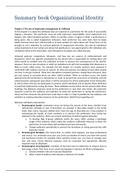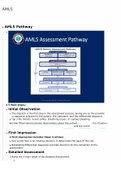Summary book Organizational Identity
Chapter 3: The arts of impression management (E. Goffman)
In this chapter it is about the attributes that are required of a performer for the work of successfully
staging a character. The performer must act with expressive responsibility, since inadvertent acts
happen, also called unmeant gestures. When an outsider enters a region in which a performance is
being given, this is called inopportune intrusions. Each performer has some facts that he keeps
hidden because these facts will discredit or at least weaken his claims about self. These facts can be
brought to one’s attention by unmeant gestures of inopportune intrusions, but also by intentional
verbal statements of non-verbal acts whose full significance is not appreciated by the individual who
contributes them to the interaction. Such disruptions of projects are called faux pas.
Unmeant gestures, inopportune intrusions, and faux pas are sources of embarrassment and
dissonance, which are typically unintended by the person who is responsible for making them and
which would be avoided were the individual to know in advance the consequences of his activity.
However, there are also situations in which an individual acts with the knowledge that dissonance is
likely to result, called scenes. For example, the last chapter of a murder mystery, were someone is
confronted with evidence and has to commit. Or when two persons are talking so loud other people
can hear it and get involved. These four disruptions (unmeant gestures, inopportune intrusions, faux
pas and scenes) in everyday terms are often called incidents. When an incident occurs, the reality
sponsored by the performers is threatened. In order to prevent the occurrence of incidents and the
embarrassment consequent upon them, it will be necessary for all the participants in the interaction,
as well as those who do not participate, to possess certain attributes and to express these attributes
in practiced employed for saving the show. These attributes and practices can be viewed under three
headings: the defensive measures (used by the performers to save their own show), the protective
measures (used by the audience and outsiders to assist the performers in saving the performers’
show) and the measures the performers must take in order to make it possible for the audience and
outsiders to employ protective measures on the performers’ behalf (tact regarding act)
Defensive attributes and practices
1. Dramaturgical loyalty: teammates must not betray the secrets of the team, whether from
self-interest, principle or lack of discretion. An example is that older people in the family
lower their voices, because children don’t have the age of discretion yet. A key problem in
maintaining the loyalty of team members is to prevent the performers from being too
attached to the audience. There are several techniques to defend against disloyalty:
a. To develop high in-group solidarity within the team, while creating a backstage
image of the audience which makes the audience sufficiently inhuman to allow the
performers to cozen them with emotional and moral immunity.
b. Change audiences periodically to prevent the formation of strong personal ties with
particular clients.
2. Dramaturgical discipline: this means that, no matter what happens, you keep professional
and serious. You remember your part, you cover up mistakes of others, you have self-control
and expression-control, for example when someone teases you, you have to manage your
face and voice. Actual affective response must be concealed and appropriate affective
response must be displayed.
3. Dramaturgical circumspection: members of the team have to determine in advance how to
best stage a show. They have to act careful and prepare in advance for likely contingencies.
a. Choose members who are loyal and disciplined
b. Select a kind of audience that will give a minimum of trouble
, c. Limit the size of both the team and the audience: the fewer members, the less
possibility of mistakes and difficulties. But, with this you have to be careful. Maybe
you have a safe show, but it also has to be a nice show and for that you need more
members to make it a success. Also, the shorter the show, the less possible mistakes
d. Not give too much or too little information on beforehand
e. Relaxation is only possible when there is a warning system for when someone
(inspector for example) comes around and when there is an appreciable time lapse
between warning and visit. For example, when a teacher leaves the room, students
can start talking, because this is something that can stop in the time lapse between
the warning and coming back of the teacher. But smoking is not something that can
be quitted in this time lapse, because the smell sticks around for a while.
f. Prepare in advance for all possible contingencies, like with a complete agenda/script
Protective practices
Most of the mentioned defensive techniques have a counterpart in the tactful tendency of the
audience and outsiders to act in a protective way in order to help the performers save their show.
These protective practices are commonly employed but better considered in conjunction with the
corresponding defensive practice.
1. Access to the back and front regions of a performance is not only controlled by the
performers, but also by others. Individuals voluntarily stay away from regions where they are
not invited (can be linked to discretion). When outsiders do enter such region, they present a
warning, like a message, knock or cough, so that the intrusion is not a surprise.
2. Also, when interaction must proceed in the present of others, for example people talking in a
restaurant, outsiders act in an uninterested, uninvolved, unperceiving fashion, so that if
physical isolation is not obtained by walls or distance, effective isolation can be obtained by
convention. This is etiquette regarding tactful inattention, which provides effective privacy.
3. When performers make a slip of some kind, the audience may tactfully “not see” the slip or
readily accept the excuse that is offered for it. When the performer is known to be a
beginner, the audience frequently shows extra consideration. Audiences are motivated to act
tactfully, because of identification with the performers or because they want to avoid a
scene or to ingratiate themselves with the performers for purposes of exploitation.
Tact regarding tact
It has been argued that the audience contributes in a significant way to the maintenance of a show
by exercising tact or protective practices on behalf of the performers. If the audience does so, the
performer must act in such a way to make the rendering of this assistance possible. This will require
discipline and circumspection, but of a special order. There are two general strategies regarding tact
with respect to tact.
1. The performer must be sensitive to hints and ready to take them, for it is through hints that
the audience can warn the performer that his show is unacceptable and that he has to
modify it quickly to save the situation.
2. If the performer is to misrepresent the facts in any way, he must do so in accordance with
the etiquette for misrepresentation: he must not leave himself in a position from which even
the lamest excuse and the most co-operative audience cannot extricate him.
Chapter 4: An integrative theory of intergroup conflict
Social categorization and intergroup discrimination
In-group bias is the tendency to favor the in-group over the out-group in evaluations and behavior.
The perception of belonging to two distinct groups (social categorization) is sufficient to trigger
intergroup discrimination. Just the awareness of the presence of an out-group is enough to cause
intergroup competitive or discriminatory responses. It seems that for discrimination, there is no
conflict of interests or previously existing hostility between the groups needed.








